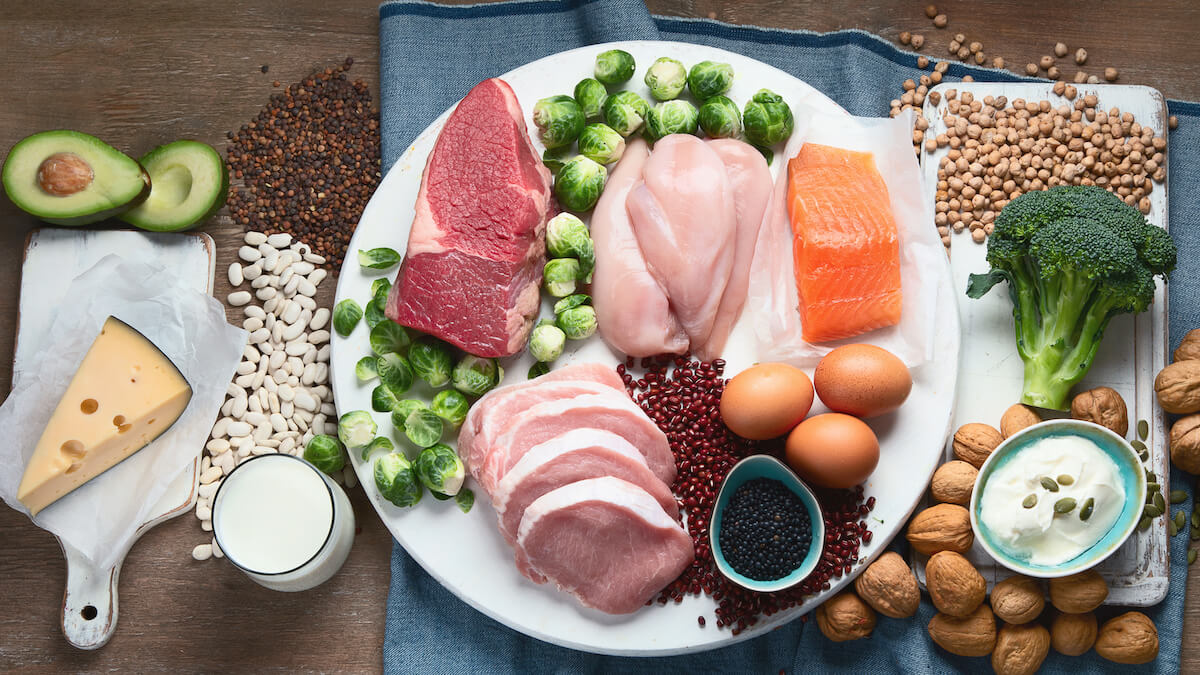
12 May How to Clean Bulk: 4 Steps to Muscle-Building Success
Bodybuilding is all about building your muscle size, strength, and definition. But your goals might be different depending on the season. Sometimes you’re focussed on weight loss or weight gain, and other times you simply want to build muscle while maintaining your weight.
When you’re aiming to lose weight, you’re cutting, and when you gain weight, you’re bulking — the latter usually during the off-season. Cutting is a story for another day. Our question here is how to clean bulk rather than dirty bulk.
Let’s explore clean bulking versus dirty bulking, why the difference is important, and how to clean bulk in a way that supports your body.
What’s the Difference Between Clean Bulk and Dirty Bulk?
In a nutshell, bulking involves weight gain. There’s a big difference between dirty bulk and clean bulk — or lean bulk — and that difference lies in your body composition.
When you clean bulk, you’ll experience some fat gain, but the majority of your extra weight will be in the form of lean muscle mass. Apart from any bodybuilding goals, that lean mass offers many health benefits, including improved heart health, stable blood sugar levels, and increased metabolism.
On the other hand, when you dirty bulk, you may experience some muscle growth but you’ll also probably end up carrying excess fat. That means you’ll have to work extra hard on fat loss to reduce your body fat percentage during your next pre-season cutting phase. And in the meantime, that extra fat isn’t so good for your body. Just for starters, it contributes to a higher risk of cardiovascular disease.
Your best approach: clean bulk rather than dirty bulk.
How to Build Muscle
To understand how to clean bulk, we need to know how muscle is formed. Simplified, that equation is: protein + strength training = muscle.
When you consume protein, your body breaks that down into its constituent amino acids. Those amino acids are recombined through protein synthesis to form the proteins your body needs to build your entire physical structure, including your bones, organs, and muscles. Resistance exercise supports that process.
In other words, if you don’t get enough calories from protein and other important nutrients — plus do enough resistance exercise — you can’t build muscle.
So how can you clean bulk rather than dirty bulk? Let’s look at the steps involved.
How to Clean Bulk: 4 Steps

When you’re clean bulking, there are a few factors involved. Let’s start with your calorie intake.
1. Add Calories
If you want to bulk up in any way at all, you need to eat extra calories. It’s crucial to make sure you’re giving your body enough calories to build muscle and gain weight, over and above what you’re using to work out. If you don’t give your body the fuel it needs, it will start breaking down your muscle to access the glycogen stored there — and as a bodybuilder, the last thing you want is to lose muscle mass. But how you create that caloric surplus makes all the difference.
How to dirty bulk:
Eat as many calories as you can get your hands on.
How to clean bulk:
Start by working out the maintenance calories for your gender, age, height, weight, and activity level. Calorie counters like MyFitnessPal or Lose It! are helpful here. Then increase that by adding an extra 10-20% of your daily calories, tending towards the high end of that range if you’re more of a novice bodybuilder. That will probably come out somewhere around 300-500 extra calories per day.
Of course, there are different kinds of calories, depending on the type of food you eat, which leads us to our next factor: what you eat.
2. Manage Your Macros
To clean bulk, you need to make sure the calorie surplus in your bulking diet goes towards building muscle rather than body fat. That means your meal plan should revolve primarily around whole foods that are packed with nutrients. Junk foods or processed foods contain empty calories that don’t give your body what it needs for muscle growth.
The macronutrients are protein, carbohydrates, and fats. While the protein helps you build muscle, the carbs and fat give you energy for your intense workouts.
How to dirty bulk:
Fill up with large amounts of fried chicken, onion rings, pizza, fries, desserts, cookies, chips, sweetened breakfast cereals, candy, alcohol, or sugary soft drinks. (To be clear, we do not recommend this.)
How to clean bulk:
Aim for a calorie ratio of 25-30% protein, 15-20% fat, and 55-60% carbs.
Your meal plan should include plenty of healthy foods. That means lean protein, like chicken or turkey, ground beef, fish, eggs, legumes, nuts, and seeds, along with healthy carbs, like baked potatoes, sweet potatoes, whole-grain rice, quinoa, and oatmeal. You’ll also need some healthy fats from foods like olive oil, nut butter, cottage cheese, avocados, and, of course, plenty of fresh fruit and vegetables to provide all the micronutrients your body needs.
Remember that as a bodybuilder, protein is especially important, and you need at least 2 grams of protein per kilogram of body weight every day. There’s also only so much protein your body can absorb at once, so your protein intake needs to be split over the course of your day.
3. Amp Up Your Resistance Training

As we’ve already discussed, the other key “ingredient” for muscle gain is resistance exercise.
This applies whether you’re dirty bulking or clean bulking. It’s just going to be a lot more difficult if you’re dirty bulking because your body won’t have the nutrient resources necessary for an intense workout or for muscle building.
Aim for about four weight training sessions per week, rotating between different muscle groups to give each some recovery time. Compound movements that work many muscle groups at once — like pull-ups, deadlifts, and squats — can also work well. Just watch for overtraining any particular muscle group.
To keep the muscles stressed and boost their growth, increase your time under tension. Your goal should be to keep your reps high — between 8 and 15 per set — even if you need to slightly reduce the weight you’re lifting.
Although your focus may be weightlifting, don’t forget to include a couple of days of cardio. Cardio helps reduce fat gain and is good for your heart and overall health. Don’t push it too hard or you’ll end up burning too many of those precious calories.
Rest and recovery time is also extremely important as that’s when your body repairs the muscle damage you’ve done during your workout — and in the process, the muscle grows. That rest time also includes getting a good night’s sleep so your body can complete its repair work.
4. Monitor Your Lean Bulking Progress
Everybody is different, so although there are general rules for how to clean bulk, you need to check if those are working for you. Once you’ve put your targeted meal plan and strength training program in place, you need to monitor that.
How to dirty bulk:
Keep eating and working out without paying any attention to the effects on your body.
How to clean bulk:
During a bulking phase, you’re aiming to put on around 0.25-0.5% of your body weight each week but bulking can take some time, so check your progress every four weeks or so, rather than every week. If you’re gaining more than the recommended amount of extra weight, you may want to cut back on your calories. If you’re not gaining anything, try increasing your calorie intake. Also, notice how your body feels with your current meal plan and exercise routine, then adjust as necessary.
Best Supplements to Support Clean Bulking

Now that you know how to clean bulk, you may be wondering what supplements will best support this process.
We’ve established that clean bulking is all about packing on that lean muscle mass. We also know that building muscle requires a high protein intake. Getting that much protein from food alone can be a real challenge. That’s when a protein powder like whey or pea protein can help to fill the gap. You might also consider adding some additional supplements like creatine or caffeine.
Protein powder is a simple and convenient way to add extra protein and extra calories if you choose. It mixes easily into a protein shake or smoothie so that you can sip it on the go. Or you can use it in more substantial home-cooked meals like oats, stews, or soups.
The key here is to choose the highest quality, purest, and most bioavailable protein powder you can find. Look for protein powders that contain Ingredient Optimized ioWhey Protein or ioPea Protein. For example:
Ingredient Optimized protein powders have been independently proven to be more bioavailable than non-optimized products, they’re free of sugar, artificial sweeteners, colors, or flavors, and they’re also USDA-certified organic.
How to Clean Bulk? Make Healthy Choices That Support Your Body
As a bodybuilder in a bulking phase, your goal should be to clean bulk. How you do that is by building as much lean muscle mass as possible.
That means carefully increasing your calorie intake, choosing the right nutrient-rich foods and supplements — especially high-quality protein — and increasing your resistance training.
Get it right, and you’ll be primed and ready to rule the next bodybuilding season.


